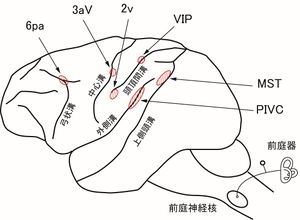杉内友理子
東京医科歯科大学 大学院医歯学総合研究科 システム神経生理学
DOI:10.14931/bsd.1776 原稿受付日:2012年5月28日 原稿完成日:2015年12月17日
担当編集委員:田中 啓治(独立行政法人理化学研究所 脳科学総合研究センター)
英語名:vestibular sensation
同義語:平衡感覚、前庭感覚
前庭器官の刺激により生ずる感覚を平衡感覚、あるいは前庭感覚という。半規管が刺激されると回転感を、耳石器が刺激されると直線運動や傾斜の感覚を生じる。さらに、視覚や体性感覚などの感覚入力も随伴し、それらすべてを統合した複合的な感覚として、平衡覚、あるいは空間識(空間における自己の位置・方向・姿勢などの正しい認識)が形成されている。
前庭器官の刺激により生ずる感覚を平衡感覚、あるいは前庭感覚という。半規管が刺激されると回転感を、耳石器が刺激されると直線運動や傾斜の感覚を生じる。しかし動物の日常生活においては、前庭器官が刺激されるような状況では、通常、視覚や体性感覚などの感覚入力も随伴し、それらすべてを統合した複合的な感覚として、平衡覚、あるいは空間識(空間における自己の位置・方向・姿勢などの正しい認識)が形成されている。
前庭器官からの情報は、前庭神経核に入り、視床を介して大脳皮質に至り、そこで情報処理を受けて、平衡覚を生じると考えられる.Penfield[2]によるヒト大脳の電気刺激実験や、てんかん発作中に前庭性感覚が生じた症例の研究により、古くから側頭葉の後部が平衡覚に関与していると考えられてきた。
サルにおける研究では、大脳皮質の複数の領域に、前庭器からの入力が存在することが知られており、前庭皮質と呼ばれている。頭頂連合野に属する2野(頭頂間溝の先端部)[3]、3aV野(体性感覚野の背外側部)[4]、MST野(medial superior temporal area)[5] [6] [7]、T3野(外側溝の底部)、頭頂葉-島前庭性皮質(PIVC, parieto-insular vestibular cortex)[8]、6pa野 (6野の弓状溝後部領域)[9] [1]、VIP野(ventral intraparietal area)[10]、23c/6c野(帯状溝近傍)[11]において、前庭入力が存在することが知られている[12] [13]。2野、3aV野は体性感覚野であり、6pa野、 23c/6c野は体性運動系である。VIP野、T3野は視覚系に属し、MST野は追従眼球運動(ocular following response, ゆっくりと動く視標を追う眼球運動)の発現に深く関与する領域である[5]。
視覚系や聴覚系に見られるように、一般的に感覚系においては、その感覚種に固有の一次感覚野が存在し、より高次の感覚野において、複合的な刺激に応じる活動を示す神経細胞が認められるようになる。しかし、平行覚に関わる上記の皮質部位にはいずれも前庭入力のみではなく他の感覚入 力も同時に存在する。一次前庭野の存在については議論があり、多くの意見は一次前庭野の存在について否定的である。そして前庭皮質のいずれもが、視覚や体性感覚などの他の感覚情報とともに前庭入力を総合的に処理していると考えられる。
上述した複数存在する前庭皮質は、相互に線維連絡があることが知られており、中でもPIVCは、他のすべての前庭皮質から入力を受け、前庭皮質系(vestibular cortical system) の中で中心的役割を果たすと考えられている[13]。ヒトでは頭頂側頭前庭野(temporoparietal vestibular area)がサルのPIVCに対応し、外耳道への冷水注入刺激(カロリックテスト)により賦活される領域[14]と相同とされる。
動揺病(乗り物酔い,船酔い)は、過度の前庭刺激によりおこる自律神経の反応(悪心、嘔吐、血圧低下、冷汗など)である。視覚や体性感覚との間に整合性がない前庭刺激に曝され、それらの情報を統合して通常の空間識を形成できず、中枢神経内での情報処理過程が破綻した状態と考えられている。例えば、車に乗って、車内の物体のみを見ている場合、車の上下動などによる前庭入力は存在するが、網膜上の対象物の像はあまり動かないために、前庭入力情報と視覚入力情報の間に乖離が起き、乗り物酔いが発症すると考えられる。また、動物が主体的に運動する場合には、視覚入力と前庭入力の間に乖離は起きないので、乗り物酔いはおこらない。
関連語
参考文献
- ↑ 1.0 1.1
Sugiuchi, Y., Izawa, Y., Ebata, S., & Shinoda, Y. (2005).
Vestibular cortical area in the periarcuate cortex: its afferent and efferent projections. Annals of the New York Academy of Sciences, 1039, 111-23. [PubMed:15826966] [WorldCat] [DOI] - ↑
PENFIELD, W. (1957).
Vestibular sensation and the cerebral cortex. The Annals of otology, rhinology, and laryngology, 66(3), 691-8. [PubMed:13488343] [WorldCat] [DOI] - ↑
Fredrickson, J.M., Scheid, P., Figge, U., & Kornhuber, H.H. (1966).
Vestibular nerve projection to the cerebral cortex of the rhesus monkey. Experimental brain research, 2(4), 318-27. [PubMed:4959658] [WorldCat] [DOI] - ↑
Odkvist, L.M., Schwarz, D.W., Fredrickson, J.M., & Hassler, R. (1974).
Projection of the vestibular nerve to the area 3a arm field in the squirrel monkey (saimiri sciureus). Experimental brain research, 21(1), 97-105. [PubMed:4213802] [WorldCat] [DOI] - ↑ 5.0 5.1
Kawano, K., Sasaki, M., & Yamashita, M. (1980).
Vestibular input to visual tracking neurons in the posterior parietal association cortex of the monkey. Neuroscience letters, 17(1-2), 55-60. [PubMed:6820482] [WorldCat] [DOI] - ↑
Thier, P., & Erickson, R.G. (1992).
Vestibular input to visual-tracking neurons in area MST of awake rhesus monkeys. Annals of the New York Academy of Sciences, 656, 960-3. [PubMed:1599231] [WorldCat] [DOI] - ↑
Shenoy, K.V., Bradley, D.C., & Andersen, R.A. (1999).
Influence of gaze rotation on the visual response of primate MSTd neurons. Journal of neurophysiology, 81(6), 2764-86. [PubMed:10368396] [WorldCat] [DOI] - ↑ Grüsser O-J, Pause M, and Schreiter U.
Neuronal responses in the parieto-insular vestibular cortex of alert Java monkeys (Macaca fascicularis).
In: Physiological and pathological aspects of eye movements, edited by Roucoux A, and Crommelinck M. Hague: W Junk Publishers, 1982, p. 251-270. - ↑
Fukushima, K., Fukushima, J., & Sato, T. (1999).
Vestibular-pursuit interactions: gaze-velocity and target-velocity signals in the monkey frontal eye fields. Annals of the New York Academy of Sciences, 871, 248-59. [PubMed:10372076] [WorldCat] [DOI] - ↑
Bremmer, F., Kubischik, M., Pekel, M., Lappe, M., & Hoffmann, K.P. (1999).
Linear vestibular self-motion signals in monkey medial superior temporal area. Annals of the New York Academy of Sciences, 871, 272-81. [PubMed:10372078] [WorldCat] [DOI] - ↑
Akbarian, S., Grüsser, O.J., & Guldin, W.O. (1993).
Corticofugal projections to the vestibular nuclei in squirrel monkeys: further evidence of multiple cortical vestibular fields. The Journal of comparative neurology, 332(1), 89-104. [PubMed:7685782] [WorldCat] [DOI] - ↑
Fukushima, K. (1997).
Corticovestibular interactions: anatomy, electrophysiology, and functional considerations. Experimental brain research, 117(1), 1-16. [PubMed:9386000] [WorldCat] [DOI] - ↑ 13.0 13.1 松波謙一
大脳と体平衡、21世紀耳鼻咽喉科領域の臨床 Clinical Textbooks of the Ear, Nose and Throat Regions 21, 野村恭也, 小松崎篤, 本庄巌編
中山書店, 1999. p. 157-169 - ↑
Friberg, L., Olsen, T.S., Roland, P.E., Paulson, O.B., & Lassen, N.A. (1985).
Focal increase of blood flow in the cerebral cortex of man during vestibular stimulation. Brain : a journal of neurology, 108 ( Pt 3), 609-23. [PubMed:3876134] [WorldCat] [DOI]
